Using the sand-cement screed for leveling a floor covering can lead to increased pressure on the inner lining plate. In order to avoid overloading should use lightweight materials - monolithic penopolistirolbetonom. It is made with cement and polystyrene. A mixture of these components provides a made of polystyrene concrete floor screed, warm enough, light, resistant to cracking and shrinkage. Such properties are provided due to the characteristics of the foamed polystyrene pellets. Moreover, the density, and weight received warm ties can vary depending on the application by changing the proportions of their constituent materials.
And in order to make the base more rapid use ready-mixed Knauf UBO. This dry mortar based on a special cement and polystyrene granules as a filler. Permitted layer thickness of 3 - 30cm.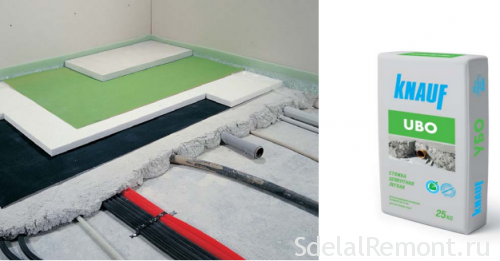
Polystyrene coating is currently considered one of the most popular. A principal reasons for this are the following advantages warm ties of reinforced penopolistirolbetona:
- increased service life compared to most other plastics;
- good thermal properties, allowing to obtain a comfortable indoor climate, even without additional insulation;
- environmental security, obtained by the use in the manufacture of polystyrene food material just filled into the cement.
Besides, among the advantages of the base foam polystyrene is the simplicity of its manufacturing. Pouring light screed for floors can be performed directly on the object and in virtually any environment. The more so because the installation dimensions for the mixing does not exceed 0,8 m in width, and weight - 100 kg.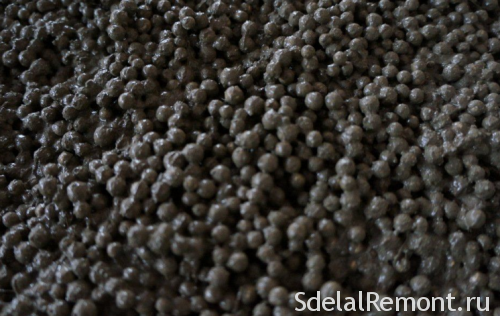
The disadvantages of the resulting floor covering may include only two characteristics of the material - of its relatively high price. If you buy ready-mix the UBO bag weighing 25 kg.(a rather large bag) It costs about 450 rub. At a flow rate of dry mix 1 m at a layer thickness 30 mm -17,6 kg.
In any case, when using light fillings have to do even more reinforcing cement floor screed.
Options for floor screed insulation
Despite, that polystyrene can delay the loss of heat, even without additional insulation, it is recommended to increase the thermal insulation by insulation floor screed. To do this, use a variety of materials, including expanded clay, and polyurethane foam. Besides, may be used with foamed polystyrene flooring Water heating system - especially, in private houses, where autonomous heating.
Expanded clay is the most popular insulation under the floor screed and a high degree of environmental friendliness and fire resistance. The material is sufficiently agile and require careful handling at expanded clay floor screed. Although quite effective for creating thermal insulation, its thickness should be not less 150 mm, which reduces the height of the room. Therefore keramzit not use in rooms with low ceilings.
The materials for the floor screed, suitable for warming ties, carry and foam plates or pellets. In the first case, the foam is placed under the screed. When using granules, they are added directly to a coupler in proportions 1:1 to the base material.
A good one for insulation and can be called, having more and a good sound insulation properties. Although due to the high hygroscopicity it should be isolated from direct contact with water, and a relatively small strength requires the obligatory use of reinforcing mesh, but in the concrete floor floor do not use it.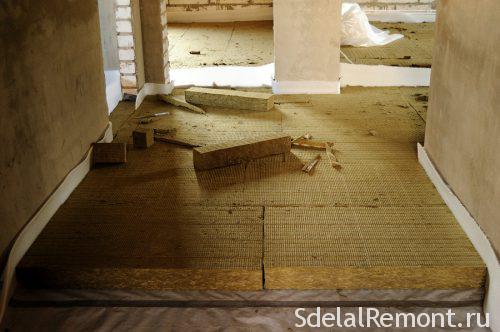
Thermal insulation may be performed under the screed floor and via Penoplex - polymeric material, which is made from closed cell structure. Heater characterized by high moisture resistance and compressive strength, as well as a good fire resistance. On penopleksovye plate necessarily mounted waterproofing film and reinforcing mesh. A thickness applied on top of the screed must be at least 40 mm.
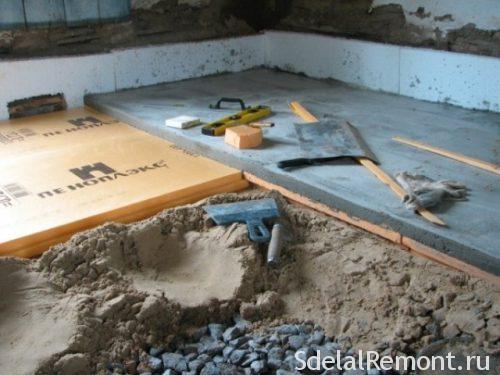
Another insulation under the screed floor heating -napylyaemy to the surface and does not require additional steam- and waterproofing. Low thermal conductivity provides minimal deposition thickness, whereby the height of the room is almost not decreased. And the process of applying the material to the surface takes a minimum of time - after 3 hours after this you can proceed to the application of the screed.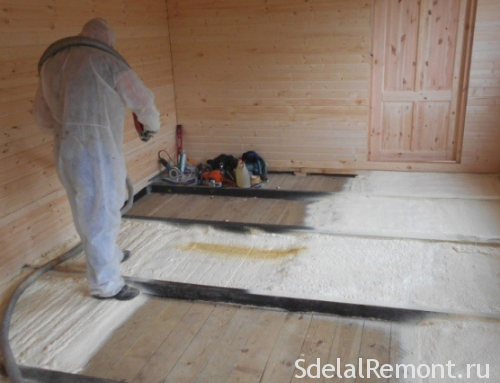
Performing a warm screed floor with their hands, It can be used to improve thermal characteristics of the coating piping system, feeding from the autonomous or centralized heating. In this case it is essential to arrange waterproofing and placed on top of the pipes aluminum foil to reflect heat energy. And only then arrange screed.
The table shows the characteristics of various kinds of warm screeds.
|
position |
Expanded (70 mm) + |
foam concrete (60 mm) + |
Styrofoam (40 mm) + |
Minvata (50 mm) + |
polystyrene (50 mm) + |
| Primer |
+ |
+ |
|||
| gidrobarer |
+ |
+ |
|||
| insulation |
+ |
+ |
+ |
||
| Work on a heater |
+ |
+ |
+ |
+ |
|
| reinforcing mesh |
+ |
+ |
|||
| Solution |
+ |
+ |
+ |
+ |
+ |
| Work on the main screed |
+ |
+ |
+ |
+ |
+ |
| total weight 1 sq.m.. |
115 kg |
82 kg |
64 kg |
72 kg |
48 kg |
| "Pie" Thickness |
110 mm |
100 mm |
80 mm |
90 mm |
80 mm |
| average price, RUR / m2 |
720 |
610 |
590 |
650 |
490 |
Preparatory work
Before, how to make a warm floor screed, required to select suitable materials and to prepare the base. For this purpose, the floor covering is removed the remains of the old finish, in this way, that only concrete remained for cleaning. Thereafter, the base channels for communications laid - wiring and piping (if necessary, the cable channels are used for this purpose).
Next stage - processing waterproofing mastic concrete slab or flooring special membrane vlagozaschischayuschey. Now you can stick to the lower part of the wall damper tape, able to protect screed from cracking and enhancing sound insulation parameters overlap.
At the time of preparatory work should already be selected and purchased a suitable polystyrene foam, and all the necessary components for the preparation of screeds. Main material, usually, sold in bags on 170 or 420 liters, and a special air-entraining additive DLS (wood saponified resin) - in the form of powder or solution. The presence of SDS allows to make Insulated floor screed even more warm and easy-to-work.
Preparation of the solution
To prepare the solution, from which it will be executed screed, It can be used not only the main components (cement, and expanded polystyrene), but also several additional components. So, eg, adding sand, increase the strength of the floor covering. Although this reduces the thermal characteristics of the material and, conversely, increases the density. As fillers and natural stone can be used to tie underfloor, raising the strength of the material to abrasion, and gravel or pebbles. It is not recommended to add concrete crumbs solution, slag and ash, which reduce the strength of the floor covering.
There is another part to the use of sand, which may make their own hands. The proportions of cement is important to observe the correct cooking possible without the use of sand. To save the next cell; take 1 part cement, 2 parts sand and 5 penopolisterolnyh granules and mixed. Such composition may be used in the construction of walls.
One of the most popular ways, how to tie a warm floor with their hands is to use polystyrene brand 300, which requires 240 kg of cement per 1 cubic meter polystyrene beads, 0,65% by volume and up to LMS 120 liters of water.
the ratio of components, necessary for obtaining different material strength, It can be taken from the table.
| Make polystyreneconcrete | The volume of polystyrene, cube. m | cement Weight, t | Water volume,
cube. m |
Percentages DLS additives, % |
| 200 | 1 | 0,16 | 0,1 | 0,8 |
| 300 | 1 | 0,24 | 0,12 | 0,65 |
| 350 | 1 | 0,29 | 0,13 | 0,62 |
| 400 | 1 | 0,33 | 0,15 | 0,6 |
| 500 | 1 | 0,41 | 0,17 | 0,45 |
The cooking process is fairly simple solution - deciding whether to warm ties, how to make the right blend, perform these steps::
- The capacity required amount of water is added;
- is poured cement;
- The mixture was stirred using a drill until, until its consistency does not become similar to yogurt;
- The resulting solution was poured polystyrene.
At the final stage of cooking mixer configured indentation polystyrene beads and used in solution until, yet most of them are not covered with cement. Thereafter, switching the direction of rotation in the opposite direction, and further mixing for several minutes. The result should be a material, resembles coarse caviar, with virtually no yield.
Pouring the mixture
way of, how to fill the floor of polystyrene, provides installing beacons, that need to be aligned in the same plane. To obtain a sufficiently warm surface, and, simultaneously, not too large reduce the upper part of the room height of the guide is set at 5 cm from the base. Then begin to perform screed, moving from one of the far corners of the room to the wall and the lining material by soaked in water rules. To accelerate the process it is desirable not to perform the fill alone, and an assistant - until one performer pours material, second evens.
In the process, should pay attention to the wall, from which the remains of the solution needs to be removed in time. BUT, finished pouring the lightweight screed floor, It recommended to immediately provide the right conditions for its drying - from 15 to 25 degrees, low humidity and a complete lack of drafts. Failure allowable microclimate may cause cracks on surface. One day after the completion of the work necessary to remove the guide and seal the rest of their holes with the same mixture.
Dry screed using GOLS
Due to the fact that the perfectly flat surface using polystyrene to obtain in a short time is impossible, use other methods of creating a floor covering. One of them is on the warm floor dry screed Knauf , feature is not filling the liquid mixture, and filling a special expanded clay backfill. The main steps of this process are:
- Substrate preparation;
- Laying of waterproofing and insulation;
- Filling the base material. The thickness dry screed Knauf should be no more than 3-5 cm.
The advantages of this floor include increasing its speed stacking, high thermal and acoustic insulating characteristics, as well as minimum loss of height in the room. It is worth noting the absence of such an advantage, as the need to wait 2-3 weeks to completely dry surface. And to Disadvantages of warm dry screed floor Knauf carry unless relatively high material costs and an increased level of dustiness. Because of this, to carry out the work only requires the use of special personal protection equipment - suits and respirators. While all funds, spent on the creation of using a lightweight screed floor heating, pay off a notable passage of time completion of repairs.












